Facilitation in Inducing Folie a Deux Through Healthy Precipitator
To the Editor: Folie a deux is a psychotic disorder characterized by a shared delusion that is instigated by a psychotic inducer and a healthy recipient (1) . We describe an unusual case in which the psychosis in the recipient appeared only after the most influential member of the family adapted the psychotic ideas of the inducer.
“Mr. G” was a 23-year-old man with no history of psychiatric disorder. He was hospitalized with a paranoid delusion that his brother-in-law was a Mafia leader who had plans to murder him. Mr. G also heard voices telling him to kill himself or he would be subjected to torture. Consequently, he tried to strangle himself in the hospital.
Additional history revealed that Mr. G’s sister developed similar symptoms prior to his hospitalization and that she had been in close contact with him during that time. Their mother was aware of her daughter’s delusional ideas. While the mother did not believe in the delusions, she provided her daughter with unconditional support and even checked her house for surveillance equipment without asking questions. The mother felt an obligation to maintain family cohesion, even if her actions contradicted her own comprehension of reality. Therefore, she avoided any confrontation with her daughter out of fear the daughter might commit suicide, which is what an uncle did several years previously.
Subsequent to his sister’s delusions, Mr. G’s first psychotic symptoms appeared when he realized that his mother was fully supportive of his sister’s beliefs. Notably, his psychosis exacerbated only after his mother’s visits on the psychiatric ward, and his attempt to strangle himself occurred after a visit from her. He received intensive treatment with doses of diazepam (30 mg/day) as well as individual and family psychotherapy that focused on reality testing of both the patient and the family.
It became apparent that the mother played a major role in the family and had indirectly supported Mr. G’s psychosis. Following intervention to clarify the mother’s influence on Mr. G, she changed her attitude and denied explicitly the existence of his delusions. Consequently, Mr. G began to improve rapidly. After six sessions of family psychotherapy, he was free of psychosis and could be discharged.
It is generally accepted that a dyad composed of a charismatic psychotic inducer and an induced person with dependent character traits is necessary for the development of shared psychosis (2) . To our knowledge, the case presented here is the first documented case in which the pathogenic influence of a noncharismatic psychotic inducer was enhanced by a healthy charismatic family leader who was fully supportive of psychotic ideas without sharing those ideas. This case introduces the possibility that a psychotic inducer does not have to be a dominant person in a family. On the other hand, it does emphasize the role of a family leader in transmitting an induced psychosis (3) .
1. Mickaud R: Translation of Lasègue and Farlet’s paper of 1877. Le folie à ou folie communiquée. Am J Psychiatry 1964; 121(suppl 4)Google Scholar
2. Howard R: Induced psychosis. Br J Hosp Med 1994; 51:304–307Google Scholar
3. Latan B: The psychology of social impact. Am Psychol 1981; 36:343–365Google Scholar



